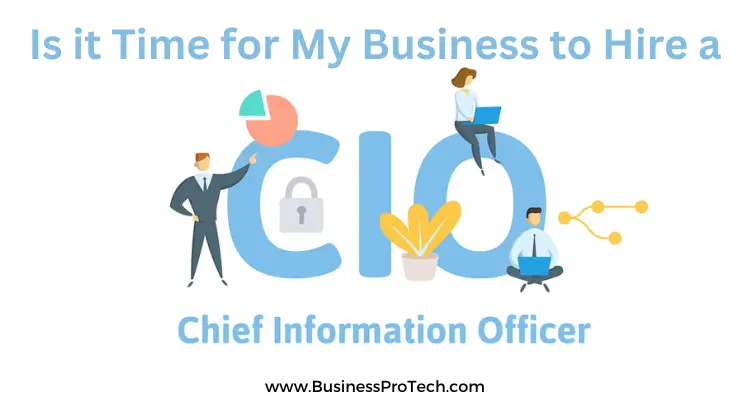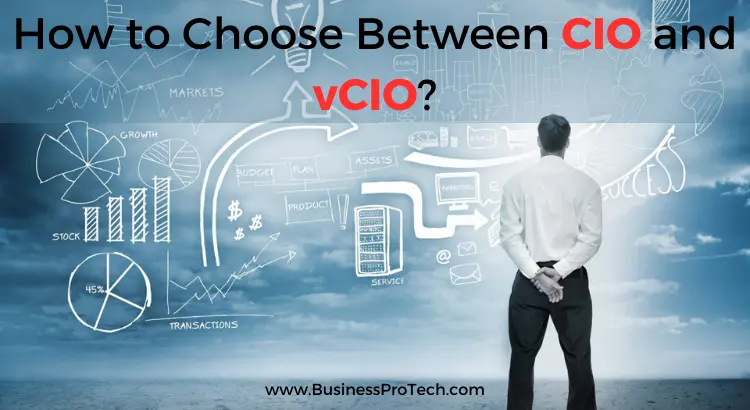Technology is a key part of every business, no matter the size. As a small business owner, you may be wondering if it is time to bring on a Chief Information Officer (CIO) to help manage your technology needs and strategy.
You may have also heard of a virtual Chief Information Officer (vCIO) and are wondering if this could be a better fit for your business.
In this blog, we will help you identify the signs that your business needs a CIO and compare the benefits and drawbacks of hiring an in-house CIO versus a virtual one.

What is the Role of a CIO?
A CIO or vCIO plays a crucial role in an organization by overseeing the management, implementation, and use of information technology (IT) and computer systems. The CIO is a key decision-maker in the company’s technological infrastructure and helps the organization leverage technology to achieve its strategic goals.
Some of the key responsibilities of a CIO include IT strategy and planning, infrastructure and systems management, cybersecurity and risk management, governance, and compliance, budget and resource allocation, vendor management, innovation, and digital transformation, IT support and services, IT team leadership, and collaboration with other C-suite executives to ensure that technology aligns with the overall business strategy.
Signs that You Need a CIO
The best way to gauge if your business is ready for a CIO is to assess the current state of your technology capabilities and your growth goals. The below signs indicate your company might need a CIO to help manage and optimize its IT infrastructure and strategy.

Rapid Expansion
If your business is growing quickly, a CIO can help manage the increased demands on your IT infrastructure, ensuring it scales effectively to support your business needs. This is particularly important if your company is increasingly relying on technology to drive its operations.
As your organization’s IT infrastructure becomes more complex, a CIO can help oversee its management, ensuring that systems stay secure, efficient, and well-integrated. Additionally, a CIO can help your business make more informed decisions regarding technology investments that support future growth.
Inefficient IT Processes
Inefficient IT processes can be another sign that your company needs a CIO. For example, your employees may be spending an excessive amount of time on manual data entry or troubleshooting IT issues. Your company may also be struggling to manage, analyze, and secure its data effectively.
A CIO can help identify areas of improvement and implement best practices to optimize performance. They can also help develop and implement data management strategies and policies to mitigate risks and ensure compliance with industry standards and regulations.
Digital Transformation
If your organization is planning to undergo a digital transformation, a CIO can help identify and implement innovative technologies and practices, ensuring a smooth and successful transition. A CIO can provide the leadership, strategic vision, and expertise needed to elevate your business’s digital capabilities and competitiveness.
This is also relevant if your company is embarking on several IT projects or initiatives that require coordination and alignment with your business goals. A CIO can help prioritize, manage, and successfully execute these efforts.
CIO vs vCIO
A Chief Information Officer (CIO) is a full-time, in-house executive while a virtual Chief Information Officer (vCIO) is an external consultant or service provider who works on a contract or part-time basis.
vCIOs are often hired by small to medium-sized businesses that cannot afford to hire a full-time CIO but still need guidance and support in their IT operations and strategy.
Cost
A full-time CIO comes with a higher salary, benefits, and overhead costs, making it a more expensive or unaffordable option for small and medium-sized businesses.
According to Glassdoor, the national average salary for a full-time CIO in the United States is $304,706 per year. A vCIO is usually more cost-effective for smaller organizations, as they are hired on a contract or part-time basis.
Perspective and Knowledge
A CIO has a deep understanding of the organization’s IT infrastructure, business processes, and culture, enabling them to make informed decisions. Meanwhile, a vCIO can offer an unbiased, external perspective, helping to identify areas of improvement and opportunities for innovation.
This external perspective can bring fresh insights and ideas to the table, complementing the knowledge of your IT team.
Range of Expertise
A single in-house CIO may have limitations in their knowledge and expertise, potentially creating gaps in the organization’s IT strategy. They might also become resistant to change, sticking to familiar strategies and technologies even when they are no longer effective.
On the other hand, vCIOs often work with multiple clients, giving them exposure to various industries, technologies, and best practices. This range of expertise and experience can benefit your business.
Flexibility and Scalability
Hiring a vCIO provides more flexibility and scalability compared to having an in-house CIO. A vCIO can be hired on a part-time or project basis, allowing you to adjust your IT leadership and management needs according to your business’s changing requirements.
Moreover, since a vCIO is not an employee of the organization, they can be easily replaced if your business needs change or if their performance does not meet expectations.
Availability and Commitment
An in-house CIO is readily available to address issues or emergencies and can quickly adapt to evolving issues while a vCIO may not be as immediately available, potentially causing delays in addressing issues or emergencies.
However, a good vCIO can provide round-the-clock IT support and management services and work during hours that a CIO would typically not be available.
How to Choose Between CIO and vCIO?

Deciding when to hire a CIO or opt for a vCIO requires careful consideration of your organization’s specific needs, resources, and priorities. To choose between a CIO and vCIO, assess your organization’s size, budget, and complexity of its IT requirements.
Smaller companies with limited budgets may benefit more from a vCIO, which can provide cost-effective, flexible services and bring diverse insights from working with multiple clients. In contrast, larger organizations with more complex IT needs might require a dedicated, full-time CIO who can fully immerse themselves in the company’s IT infrastructure, culture, and business processes.
Ultimately, the decision should be based on your organization’s unique circumstances and the value that each option can bring to achieving your strategic goals.